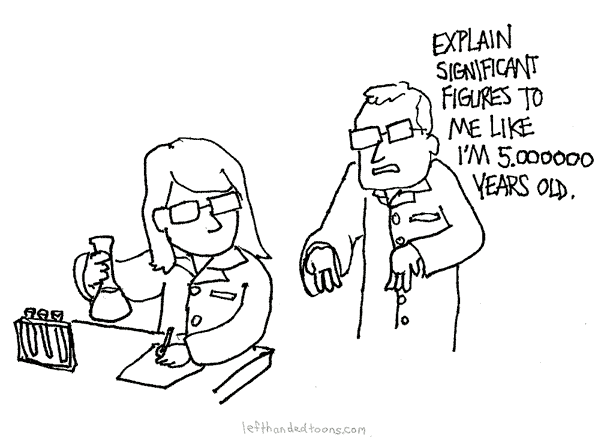
Significant digits (sometimes called significant figures or abbreviated to sig digs/sig figs) are a way of ensuring that we are calculating numbers to the correct amount of precision.
For example, when we are taking measurements in a laboratory, we want to make sure that any calculation we do on those measurements are precise. We can do this by using significant digits. Significant digits are particularly important in engineering, chemistry, physics and many other sciences as these areas require number precision throughout calculations.

We start counting the number of significant digits at the leftmost non-zero digit of the number and we stop counting after either:
1) If there is no decimal: the rightmost non-zero digit
2) If there is a decimal: the rightmost digit (could be a zero)
Examples
| Number | Number of Significant Digits | Comments | |
| 1) | \(50.0\) | 3 | There is a decimal, so start counting at the 5 and move right. |
| 2) | \(3.9\) | 2 | There is a decimal, so start counting at the 3 and move right. |
| 3) | \(0.00056\) | 2 | There is a decimal, so start counting at the 5 and move right. |
| 4) | \(8.432\times10^{-6}\) = \(0.000008432\) | 4 | There is a decimal, so start counting at the 8 and move right. |
| 5) | \(408,000\) | 3 | Start counting at the 4, but since there's no decimal, we stop at the last non-zero digit (8, in this case) |
| 6) |
\(5.89120\times10^{2}\) = \(589.120\) |
6 | There is a decimal, so start counting at the 5 and move right. |
When a number has zeros before we start counting the significant digits, we call those "leading zeros".
It's important to remember that leading zeros are not significant digits.
Example #3 above has 4 leading zeros, and Example #4 has 6 leading zeros.
Notice how, as seen in Examples #4 and #6, when a number is in scientific notation we can just count the number of digits we see in the coefficient to determine the number of significant digits.
Rounding with significant digits is identical to the usual rounding process:
Example
Round \(132.789\) to \(4\) significant digits.
Solution
We count \(4\) significant digits from left to right-- I see that we stop at the \(7\).
As the digit to the right of the \(7\) (the \(8\)) falls in the range of \(5-9\), we round \(7\) up to \(8\):
\(132.\underline{8}89\)
Then we remove all digits to the right of the \(\underline{8}\) (so \(8\) and \(9\)):
\(132.8\)
---
So \(132.789\) rounded to \(4\) significant digits becomes:
\(132.8\)
Sometimes we run into problems when rounding sig figs.
Example
Let's say we wanted to round \(159,900\) to \(3\) sig digs.
By the rules we outlined beforehand, it would become \(160\).
However, if someone else were to look at this number, they would think it has been rounded to only 2 sig digs. \(160\) by itself only has 2 sig digs.
Solution
This problem is fixed by either:
The precision of a number refers to the decimal position of the last significant digit (from left to right).
The accuracy of a number refers to the number of significant digits in the number.
Examples:
| Number | Precision | Accuracy | Comments | |
| 1) | \(675.03\) | Hundredth | \(5\) |
The number is precise to the nearest hundredth. |
| 2) | \(280\) | Tens | \(2\) | The number is precise to the nearest tens. It has an accuracy of \(2\) significant digits. |
| 3) | \(6.700\) | Thousandth | \(5\) | The number is precise to the nearest thousandth. It has an accuracy of \(4\) significant digits. |
When multiplying or dividing numbers with significant digits, the result should have the same accuracy as the least accurate number.
In other words, the result should have the same number of significant digits as the number with the least significant digits being operated on.
Example
Solve \(4.5\times89.3\) with the correct amount of significant digits.
Solution
\(4.5\times89.3=401.85\)
However, our answer must have the least amount of significant digits between \(4.5\) and \(89.3\): so two significant digits.
We can convert this into scientific notation to have two significant digits:
\(4.0\times10^2\) is our final answer.
(or \(4\underline{0}0\) or \(4\bar{0}0\))
When taking the root of numbers with significant digits, the result should have the same accuracy as the original number.
In other words, the result should have the same number of significant digits as it did before taking its root.
Example
Solve \(\sqrt{45.28}\) with the correct amount of significant digits.
Solution
\(\sqrt{45.28}=6.729041537...\)
However, our answer must have the same number of sig digs as \(45.28\): so four significant digits.
\(6.729\) is our final answer.
When adding or subtracting numbers with significant digits, the result should have the same precision as the least precise number.
In other words, the decimal position of the last significant digit in the result should be in the same spot as the least precise number being operated on.
Example
Solve \(89.901−7.1\) with the correct amount of significant digits.
Solution
\(89.901−7.1=82.801\)
However, between \(89.901\) and \(7.1\), \(7.1\) is the least precise (precise to the nearest tenth, whereas \(89.901\) is precise to the nearest thousandth.)
So, our answer must also be precise to the nearest tenth:
\(82.8\).